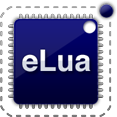Linenoise
What is linenoise?
Technically speaking, Linenoise is a small replacement library for GNU’s readline library, which is already supported by standard Lua. What it actually does is give you a nice way to edit your Lua commands inside the Lua interpreter (by using the arrow keys and other key sequences presented below) recall a line that was already entered, and save the history of the lines you entered. It’s very convenient when prototyping within the Lua interpreter, because all the lines entered at the Lua prompt can be saved and turned into a proper application by editing the saved file. It also takes the Lua interpreter much closer to its desktop counterpart with regards to ease of use.
Linenoise in eLua
Starting with version 0.8, eLua contains a port of the linenoise library. To use it, make sure it is included in the build, refer to the build instructions for details. Note that linenoise requires ANSI terminal support (BUILD_TERM), so you need to enable that too. To use it, simply start the Lua interpreter. The table below contains a list of keys that can be used to take advantage of linenoise:
| Key(s) | Action |
|---|---|
Left and right |
Move left and right in the current prompt line |
Up |
Recall the previous line |
Down |
Recall the next line |
CTRL+C |
Abandon the current line |
Home |
Go to the beginning of the line |
End |
Go to the end of the line |
CTRL+K |
Delete from the cursor to the end of the line |
CTRL+U |
Delete the current line |
To save the history, simply call elua.save_history with the name of the file in which the history will be saved
(check here for details). Be careful, the file will be overwritten.
The exact same keys presented in the table above can be used by the eLua shell if linenoise is enabled for it.
However, you won’t be able to save history from the eLua shell.
The reason why this component isn’t enabled by default is that it takes RAM (like all good things in eLua :) ) so
keep this in mind when deciding if you want it or not.
|
|
linenoise support seems to be dependent on the terminal emulator used with eLua on the PC side. It was tested (and works properly) with TeraTerm under Windows and with screen in Linux. Other terminal emulators might not work equally as well. |
